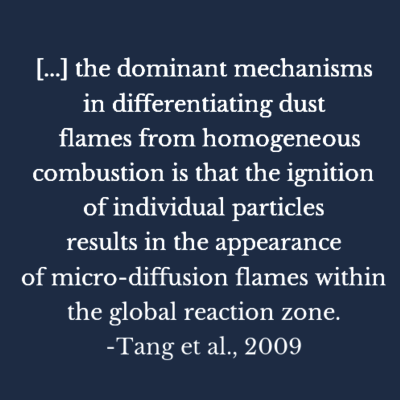1-Sentence-Summary: Laminar flame velocity and quenching distance of iron dust is explored in a reduced-gravity environment.
Authors: F. Tang, S. Goroshin, A. Higgins, and J. Lee
Read in: Three Minutes
Favorite quote from the paper:

The current authors investigate laminar flame propagation of iron dust in a reduced-gravity environment. The experiments are performed onboard a parabolic flight aircraft allowing 20 seconds of near-zero gravity. Free flames are measured in a tube open at one end, along with flame quenching by evenly spaced plates.
Four iron powders with diameters of 3.3, 7.0, 9.9, and 26.8 µm are investigated. Fuel rich conditions are tested with equivalence ratios between 1.43 and 1.9. In all cases, the iron dust cloud was ignited with a 100 µm tungsten wire.
Laminar flame velocity and quenching distance as a function of particle size are presented. Furthermore, high speed images allows analysis of the flame structure. Lastly, the experimental results are compared to a theoretical model previously developed by this group (Goroshin et al., 1996).
Three of the main findings from this paper are:
- High speed images show a continuous flame for small particles but a discrete structure for larger particles.
- Flame velocity decreases as the particle size is increased.
- Quenching distance increases as the particle size is increased.
The following sections outline the main findings in more detail. The interested reader is encouraged to view the complete article at the link provided below.
Finding #1: The iron dust flame structure becomes increasingly discrete as particle diameter is increased
High speed images of the flame propagation show a parabolic continuous structure similar to gaseous flames for small particle diameters. As the diameter increases the flame structure becomes more discrete and individual particle burning can be seen.
Although the flame structure is visually discrete, the authors argue that a continuum modeling approach can still be used for fuel rich mixtures. Following the approach of Goroshin et al., 1998 they propose a nondimensional parameter \(\xi\) defined as
\(\xi = \frac{\tau_{c}\alpha}{l^{2}}\)
where \(\tau_{c}\) is the particle combustion time, \(\alpha\) is the thermal diffusivity of the surrounding medium, and \(l\) is the inter-particle spacing.
This parameter represents the ratio of particle combustion rate to the thermal heat transfer rate between particles. For the fuel rich mixtures studied here the ratio is approximately 5, suggesting that heat from individual particle combustion is diffused very rapidly allowing for a continuum treatment.
Finding #2: Flame velocity is inversely proportional to particle diameter
The experimental results demonstrate that flame velocity is significantly reduced with particle diameter. The numerical value decreases from 55 cm/s for 3.3 µm particles to approximately 9 cm/s for 26.8 µm particles.
From comparing to theoretical analysis, the authors demonstrate that the flame velocity is inversely proportional to particle diameter (\(V_{f} \propto 1/d_{p}\)). This is consistent with previous observations found in the literature such as Cassel, 1964.
Finding #3: Quenching distance is inversely proportional to particle diameter
Quenching distance of iron dust is the final aspect studied in this work. The experimental data shows that quenching separation distance of the plates varies linearly with particle diameter (\(D \propto d_{P}\)) and ranges from 2 mm to 12 mm for the dust studied.
These results agree with theoretical considerations for dust flames. As explained by the current authors, heat loss to the plates is based on the ratio of dust combustion time (\(\tau_{c}\)) and the heat diffusion time (\(D^{2}/\alpha\)). In this relation \(D\) is the plate separation distance. Furthermore, under diffusion limited combustion \(\tau_{c} \propto d_{p}^{2}\). Lastly, the quenching separation distance is shown as \(D \propto \left(\tau_{c}\right)^{1/2} \propto d_{p}\).
My Personal Take-Aways From
“Flame Propagation and Quenching in Iron Dust Clouds”
This paper demonstrates the usefulness of reduced gravity on illustrating fundamental processes of combustion and flame propagation. The interested author is encourage to view other reduced gravity studies referenced in this work such as Kumagai et al., 1971, Ballal, 1983, Okuyama, 1996, and Dreizin and Hoffmann, 2000.
The flame structure, velocity, and quenching results found in this work are interesting and provide a groundwork for understanding dust flame propagation. For industrial safety the work that remains to be completed includes translating these findings into turbulent, terrestrial explosions in processing applications.
Full Citation: [bibtex file=references.bib key=Tang2009]
